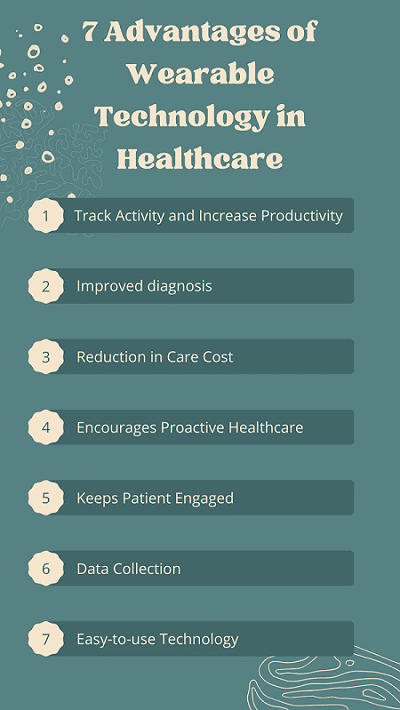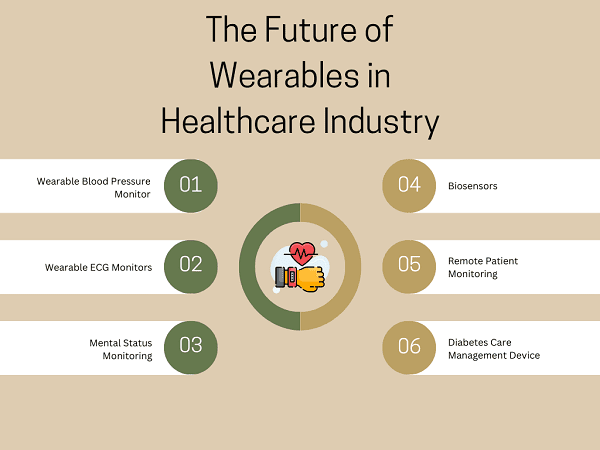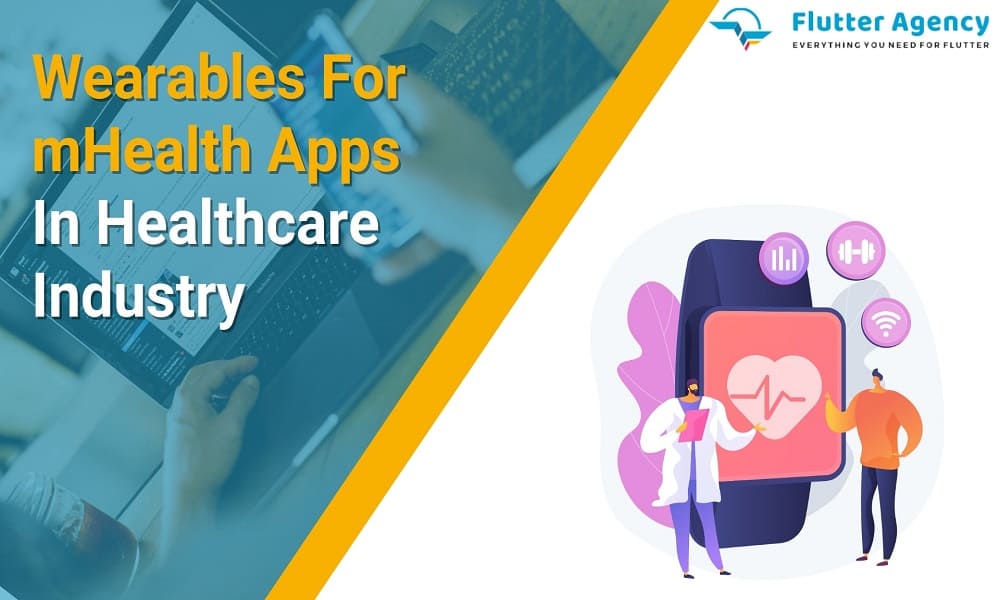Wearables For mHealth Apps In Healthcare Industry
Healthcare app development is here to stay for a long time. Still, the recent increases in the acceptance of wearable technology will identify that the potential of wearable app development has infinite opportunities.
Nowadays, in the healthcare transition, wearable technology plays an essential role. Wearables app development is wholly linked to the changing healthcare delivery approaches. Rather than commuting to a healthcare center, this new and latest approach brings care to patients wherever they are.
Usually, we think of the advancements which are going to happen in the future, but wearables have rapidly transformed the healthcare business. Wearables, which are the usual size of a wristband, can monitor blood pressure and the other necessary signs, impacting healthcare in its initial stage.
In this blog, we will see how wearable technology is used in healthcare and what the future is for this emerging technology in the healthcare industry.
Introduction to Wearable Technology
Wearable technology has the potential to provide several solutions to a healthcare system. Wearable technology solutions like weight control and health fitness monitoring aim to cure diseases and maintain health. Hence, wearable gadgets are primarily used to track patients and diagnose their ailments.
Wearable apps have the potential to have a direct effect on clinical evaluation. However, patient therapy outside hospitals will enhance the quality of care and lower the cost of wearable technology in healthcare.
Wearable device market size
The global wearable device market was valued at USD 21.3 billion in 2021. It is expected to explore the compound annual growth rate (CAGR) of 28.1% from 2022 to 2030. Hence, the growth of an industry like home healthcare and remote patient monitoring devices is anticipated to influence the market growth significantly. There is a huge demand during the COVID-19 Pandemic, and it has increased awareness about personal health monitoring and is expected to be the significant market driver.

However, because of a sedentary routine, the incidence and prevalence of lifestyle-related disorders like diabetes and hypertension are projected to increase over the forecast period. Some diseases demand continuous monitoring of various physiological parameters, such as blood sugar levels and blood pressure. It allows a combination of healthcare data with portable medical gadgets, which is forwarded to physicians to have real-time access to data and minimize errors and bugs. Hence, a rise in the mortality rate because of non-communicable diseases is the most prominent reason for concern that demands more concentration on personalized monitoring and care. Therefore, it is ultimately anticipated to increase demand for wearable medical products.
Increasing attention to fitness is the high-impact rendering driver for a market. Multiple wearable medical products and software have been developed to manage weight and fitness. Generally, wristbands are connected to mobile phones that display real-time tracking activities such as calories burned and intake, walking steps, and so on. Thus, regular study of these statistics will help you deliver a good health plan to individuals and healthcare professionals.
Benefits of Wearable Technology in the Healthcare Industry
In the modern healthcare industry, wearable devices have already made a great impression. Also, doctors in hospitals are increasingly using wearable technology to retrieve a patient’s Electronic Health Record (EHR) data or transmit the necessary clinical info during patient visits.

Wearables with increasingly powerful biosensing capabilities are also becoming more common in hospitals. Thus, the days are gone when wearables can only measure heart rate, steps, and calories.
Therefore, doctors can now measure the electrolytes, hydration, electrocardiogram, muscle load, human strength, and exhaustion level with the help of wearables.
Also, Read This Post:
Why Do Doctors Must Focus on Patient Electronic Records?
1. Track Activity and Increase Productivity
The advantage of wearable technology is that it helps to track activity and increase productivity. Tracking data like the steps taken, heart rate, and calories burnt will allow people to monitor physical activity better.
Hence, this data is used to help people make healthier choices in their daily lives. For example, if someone wants to lose weight, they may eat fewer calories than they have been consuming on average.
A wearable gadget will estimate how many calories a person has eaten every day depending on their food intake, which grants them to better keep track of their progress towards weight loss goals.
2. Improved Diagnosis
Wearable technology in healthcare apps has the potential to improvise diagnosis by granting doctors the to monitor patients remotely and will examine the issues as early as it is. In addition, wearables can give accurate and precise information rather than traditional methods. Hence, this data can be utilized to improve diagnosis and tailor the treatments to the specific patient.
3. Reduction in Care Cost
Wearable technology is the most-effective way in comparison to traditional methods. Hence, the price of wearable devices has fallen very much in recent years, making them more affordable for healthcare organizations. Moreover, the charge of operating and maintaining a wearable gadget is typically lower than other medical equipment.
4. Encourages Proactive Healthcare
One of the primary goals of wearable technology is proactive healthcare. It is the system where the patients work with doctors to manage their health and will identify any potential issues before they escalate.
Hence, it can be done in various ways, like tracking fitness levels, sleep patterns, daily activity, and heart rate. All of this information is used to make informed decisions about lifestyle and changes in diet, which can improve overall health.
5. Keeps Patient Engaged
Wearable technology will keep patients involved in their care. Thus, by permitting patients to track their progress and get real-time feedback, they are more likely to stay on track with their health goals. This technology aids in reminding patients about their medications or following up with their doctor.
6. Data Collection
A hospital or clinic staff might utilize warbles like smartwatches to collect data like heart rate, respiratory rates, glucose level, and blood pressure readings from the patients while they are being hospitalized. Hence, the data can then be shared with other providers via the telemedicine app development so that they can give the best treatment and care plans.
Also, Read This Post:
HIPAA Compliance For Telemedicine
7. Easy-to-use Technology
Wearable technology is gaining much popularity in the healthcare industry because of its easy-to-use interface and wide range of applications. With this, doctors can easily make the patient’s diagnosis with accuracy by using the tools like ECG monitors and pulse oximeters, which gives automatic data acquisition.
For instance, a doctor might place an oxygen monitor on the patient’s finger, measuring blood oxygen levels via n various body points. With this gadget, doctors can easily detect irregularities in the patient’s heart and respiration rates.
In this way, the doctors will be able to spend less time diagnosing the medical conditions, leaving them more time to focus on their treatment.
Challenges Of Wearable Technology In Healthcare
- There are some causes why wearable technology is a challenge for healthcare organizations.
- The data collected by the wearable product is sometimes unstructured and difficult to manage.
- Wearables are usually used to track sensitive health information, which raises privacy and security concerns.
- The battery life of the wearable is concise, so it must be regularly charged or replaced.
- Many of the wearables need to be compatible with existing healthcare IT systems.
- Various wearables make use of distinct formats for storing data.
The Future of Wearable Technology in Healthcare
Let’s take a look at how wearable technology will have an impact on the healthcare industry in the upcoming years.

1. Wearable Blood Pressure Monitor
Interpreting, acquiring, and monitoring the complete vision of blood pressure level is essential for long-term good health for everyone. Hence, an individual may eventually hold off these measurements regularly by using his fingers or wrist.
Wearable blood pressure (BP) monitors, which can be utilized in various gadgets like smartwatches, patches, fitness bandstands, and oximeter finger clips, have become famous later.
The most crucial characteristics needed for monitoring are photoplethysmography signal, motion signal, and static biometrics such as gender, age, and other details.
2. Wearable ECG Monitors
It is the latest technology in the community which has replaced the heart rate monitor with smartwatches and activity trackers.
The device is intended to help people keep a close eye on their heart health, and it could be used to detect atrial fibrillation, an acute medical disease that is the primary cause of stroke.
A wearable ECG monitor records small electrical signals built by a heart pounding beneath your skin and views them as a trace. It enables qualified doctors, machines, or wearables to understand better how your heart works and will find any irregularities.
Wearable ECG monitoring was first introduced by the Apple watch and is now available on some other wristbands and smartwatches like Fitbit and many more.
3. Mental Status Monitoring
Researchers have been creating wearable constant monitoring technology to enable students to get mental health care as mental health disorders have become widespread on college campuses.
A device will detect high anxiety symptoms and assist the users with any resources by using advanced machine learning and the sensors on conventional off-the-shelf smartwatches.
However, negative signs like Werner’s self-reports and the anxiety patterns in the heart rate activate a device. The wearer will be prompted to participate in rehabilitative activities if these indicators are detected.
4. Biosensors
Biosensors are the most well-known wearable technology, which sets them apart. It has a broad range of applications for the healthcare industry. Biosensors are increasingly prominent as they can measure the biofluids such as sweat, tears, spit, and interstitial fluids in real-time, which gives real-time data.
A wearable biosensor is a self-adhesive patch that enables people to go around while a gadget records its pulse, heart rate, temperature, and respiratory rate.
Recently, biosensors have been created to keep track of a patient’s condition. It is mainly used for health and fitness purposes. Thus, it can identify multiple compounds interconnected to a health condition, gives insight into any of the issues, and permits the user to act more rapidly to ignore the spread of diseases.
5. Remote Patient Monitoring
It is the delivery mechanism with a massive telemedicine sector that makes utilization of particular technologies to communicate info between clinicians and patients electronically.
Wearable health monitors remind diabetic patients to take insulin while letting the doctor check a disease. At the same time, digital blood pressure, such as Medtronic, permits patients to submit blood flow and blood oxygen levels to their doctors via the internet.
6. Diabetes Care Management Device
A patient’s diabetes care management gadget is the essential indicator of healthcare if the person has any diabetes. These devices will usually necessitate a blood sample, which is taken using the finger prick tool that comes with a gadget and will give the instant glucose reading by delivering the patient details on how effectively they are managing their diabetes.
However, suppose the device examines whether the blood glucose level is low or high. In that case, it will trigger an alert, and the app connected with it will give the patient data about glucose levels and what they may need to raise or lower diabetes appropriately.
Also, Read This Post:
Mental Health App Development: Benefits and Features
Conclusion
Wearables and healthcare play an essential role in healthcare organizations. The use of wearable technology is rapidly revolutionizing the healthcare system, as it is the benefit of mobile applications in the healthcare industry.
Many individuals worldwide have started to rely on wearable devices to finish multiple jobs, contributing to the rise in the popularity of customized wearable apps.
Therefore, wearable technology is undoubtedly beginning to transmit healthcare, and its use should be evaluated on a case-by-case basis. It is necessary to hire the best and most reliable healthcare app development company for your next healthcare project. As a top healthcare app development company, we are skilled in developing robust applications for the healthcare industry. Our skilled healthcare app developers will incorporate cutting-edge contemporary technologies like wearable technology in healthcare.
Frequently Asked Questions (FAQs)
1. How will wearable medical gadgets transform healthcare?
Wearable devices in healthcare are built to gather and use data about their health and exercise and send patients’ health information to the doctor or healthcare professionals in real time.
2. How secure are wearable devices in healthcare is secure?
Cryptographic functionality like encryption, authentication, and data protection aids in securing wearable data by making it complicated for cybercriminals to exploit. Thus, the modification helps to protect the data from conversion and forgery.
3. What is the effect of wearable technology in the healthcare industry?
Wearable devices are proven helpful and help the patient and clinician make the plan of care and track outcomes. It is also beneficial in delivering real-time data and promoting self-management for chronic conditions.
Contemporary ventures
Recent blog
ready to get started?
Fill out the form below and we will be in touch soon!
"*" indicates required fields









